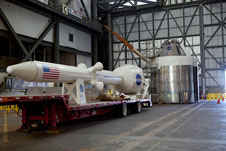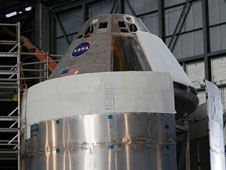 Image above: The mockup components of an Orion spacecraft are laid out in the transfer aisle of the Vehicle Assembly Building at NASA’s Kennedy Space Center in Florida. In the foreground is the Launch Abort System, then the aerodynamic shell that will cover the capsule. To the right is the Orion capsule model on top of a service module simulator. All are the exact dimensions the flight-ready Orions will be. Photo credit: NASA/Dmitri Gerondidakis
Image above: The mockup components of an Orion spacecraft are laid out in the transfer aisle of the Vehicle Assembly Building at NASA’s Kennedy Space Center in Florida. In the foreground is the Launch Abort System, then the aerodynamic shell that will cover the capsule. To the right is the Orion capsule model on top of a service module simulator. All are the exact dimensions the flight-ready Orions will be. Photo credit: NASA/Dmitri Gerondidakis
› Larger Image
 Image above: The Orion mockup and its service module simulator. Photo credit: NASA/Dmitri Gerondidakis
Image above: The Orion mockup and its service module simulator. Photo credit: NASA/Dmitri Gerondidakis
› Larger Image The Vehicle Assembly Building’s transfer aisle offered a glimpse of the future recently as a full-size Orion spacecraft mock-up was placed atop a model of the service module so engineers and technicians could determine the exact dimensions for connectors that will run from the launch pad structure to the spacecraft before liftoff.
With the first test flights of the Orion scheduled in 2014 atop a Delta IV and 2017 for a Space Launch System flight, the work is critical to making sure the designs are accurate, said Doug Lenhardt, who is overseeing the Orion mock-up and operations planning for the Ground Systems Development and Operations program, or GSDO.
After all, changing a connector on a flight-ready spacecraft or heavy piece of launch pad equipment can get costly and time-consuming.
“The design is pretty far along for the capsule, so the sooner you can find flaws or details that you want the designers to change, the less expensive it is, the more time they have to look at it and possibly redesign,” Lenhardt said. “You don’t want to test all of this out on your first flight vehicle.”
Stacked atop each other, the Orion crew module and service module mock-ups stand 27-feet tall. People can climb inside the capsule and see how the astronauts will sit for the launch and how much room is available to them during the months it may take for a mission to an asteroid or the moon or Mars. The model’s full-size gives designers a greater appreciation of the scale of the spacecraft, Lenhardt said.
“That’s the first thing people say when they see this, I didn’t realize it was that big, that it was that tall,’ ” Lenhardt said. “When you go to computer-aided design models, you just don’t appreciate the size.”
NASA routinely used mock-ups, also known as boilerplates or pathfinders, to test equipment and techniques for all of its human spacecraft programs. The Orion work is the first for NASA for a crewed spacecraft since the space shuttle. Many mock-ups retired to public display, such as the “Pathfinder” shuttle on exhibit at Marshall Space Flight Center in Alabama.
Lifting and moving the mock-ups also provides opportunities for technicians to maintain and practice their technical skills.
“That’s actually one of the big goals of the mock-ups is helping keep the work force here proficient,” Lenhardt said. “The crane guys are good, they’re really good now because they were doing orbiters three or six times a year. Now, they’re not lifting any flight vehicles, so obviously their skills will erode a little bit. It definitely does help to keep everybody proficient here, too.”
The mock-up also has been used to show firefighters and emergency medical technicians what to expect if they have to get astronauts out of the ship quickly. They saw very quickly that lifting astronauts up from their seats and out of the hatch is a lot different than it was on board a space shuttle, Lenhardt said.
“When you’re trying to get a crew out, seconds matter, so the fire and rescue guys came up with really good ideas to help the closeout do their job, to get the guys out faster,” Lenhardt said.
The demonstrations already have identified numerous changes in approaches to handling the Orion during launch preparations at the launch pad. For instance, a system of off-the-shelf scaffolds proved too difficult for crews in heavy protection gear to move around in, so a new approach is being developed.
The Space Launch System rocket is slated to be taller than a Saturn V, which means operators will have to lift the Orion and its service module almost to the rafters of the 525-foot-tall VAB to place the spacecraft on top of the SLS.
With the steel and aluminum mock-up , the engineers can find out what work needs to be done before the spacecraft is lifted and what can only be done with the Orion mated to the top of the rocket.
The Orion model, exact in details on the outside but mostly empty on the inside save for four mock-up astronaut seats and hatch, was used to practice stacking the launch abort system, or LAS, ahead of a flight test at White Sands, N.M., in May 2010. Kennedy engineers have been using it to model their systems and demonstrate processing techniques for several months, including placing it inside an experimental clean room.
For a service module, though, there was nowhere to turn to get a mock-up , Lenhardt said. So Kennedy designers came up with a framework and metal cylinder that would be the same dimensions as the service module and support the Orion’s weight. NASA and Boeing prototype shops turned the designs into the real model.
An operational service module holds tanks, power-generating solar arrays, instruments and other hardware astronauts need. It stays attached to the Orion capsule until re-entry, when the capsule separates to return the crew to Earth.
“Ours is built just for the ground, it couldn’t take the launch loads, the vibrations,” Lenhardt said. “We only needed to simulate the outside. This is how the Orion vehicle will come to us from the Operations and Checkout Building, where it is assembled. So now we can do any of the operations, simulate them, with a flight-like vehicle.”
Because the VAB’s transfer aisle is vast, it can be used to simulate other facilities, too, so work that will take place in other areas of Kennedy to prepare Orion for flight can also be perfected without moving the mock-up s around.
The model also includes an aerodynamic shell that will anchor the LAS rocket to the spacecraft. In an emergency, the LAS would ignite and pull the Orion spacecraft to safety. Workers in the VAB have not stacked a rocket with an LAS since Apollo missions ended in 1975, since the space shuttle did not have such a mechanism.
“Is it better to stack the LAS when it’s on top of the rocket, is it better to stack it on the ground here and then lift the whole thing on top of the rocket?” Lenhardt said. “Those are the kinds of things we can try out here.”
Between the pace of work increasing and with flight tests into space closer on the horizon, Lenhardt said excitement is building at Kennedy.
“We’ve got this, and with the EFT-1 spacecraft showing up in the Operations and Checkout Building,” Lenhardt said, “it shows people we are moving down a path, NASA is moving forward and it’s starting to get pretty exciting.”
6 min read




























